Text
I did not know such details as 中道 and the number "six" are related to Buddhism ideas. And your post reminds me of how sophisticated the Gihbli works and recognize the reason for Gihbli having been loved or enjoyed by all generation for long time and now as well.
In addition, it is interesting to know that the bathhouse is thought as brothel. It is true that some characteristcs seen in Yubaba's bathhouse have the same characteristics with a brothel. And it is interesting that those characteristics are shown in various ways, such as the blue color of Noren, the gender of customers of the bathhouse, and Genji names of workers.
And your thougts of Kaonashi is interesting. Trying to copying what Kaonashi thinks is impressive or attractive to Chihiro shows he? has no identity. This tells us making identity based on other's impression to myself is wrong way of making my indentity. Lastly, Kaonashi finds out what only he can do and seems to be able to accept himself as he is.
Spirited Away by Hayao Miyazaki
Released in 2001, Spirited Away is a Studio Ghibli film directed by Hayao Miyazaki. It's a masterpiece with beautiful world-building, stunning visuals, and enchanting music, making it enjoyable no matter how many times you watch it. It's my favorite among Ghibli's works, and upon watching it again after a long time, I made many discoveries.
The scenes I particularly love feature Kamaji, the boiler man, and the spirit resembling a white radish, known as Oshira-sama. Kamaji treats and says Chihiro like his granddaughter, protects her, gives her train tickets, tucks Haku into a futon, and even sits beside him until he wakes up. He's a warm and endearing grandfatherly figure. Oshira-sama doesn't speak but protects Chihiro. Modeled after a deity worshipped in the Tohoku region known for its fondness for children, Oshira-sama likely protected Chihiro due to this characteristic.
Another scene I adore is when the transformed Bo, a mouse, reenacts the scene of "えんがちょ / Put your thumbs and forefingers Together! Evil be gone!” with the soot sprites, which is cute and charming. Also, the meticulous attention to detail in the film, like the sign at the izakaya run by spirits saying "おいでおいでおいで… / Come, come, come…” or the ledger-like characters on the bathhouse walls such as “葬儀 / funeral", “大入 / big entrance”, and “貸借 / lending and borrowing”, adds to its allure.
The character of the River Spirit, Okusare-sama, being polluted by humans also serves as a critique of modern society. Furthermore, elements of Buddhism are incorporated alongside Shintoism, as seen with the “中道 / middle path" inscription on the train and the reference to the sixth station, indicating a blend of spiritual themes.
The opening scenes, with numerous houses of gods and a torii gate, suggest that the world Chihiro stumbles into is that of the gods. The bathhouse run by Yubaba is said to be a place where the Yorozu no kami come to relax from their daily fatigue, though it's speculated to possibly be a brothel. In the movie, when night falls, the bathhouse becomes brightly lit and bustling, reminiscent of a lively night city street. Many kami visit, and within the private baths, women attendants wash their bodies of them. In the morning, those descending from the sleeping quarters are with women. Some women are wearing revealing clothing. The clientele, who are gods, are male, as indicated by the blue color of the curtains bearing the character for “湯 / hot water". Employees have their names taken away and are given pseudonyms, a characteristic of brothels. Also, the blackened newt is an aphrodisiac, and this is implied in the film like Rin's blushing cheeks when Kamaji gives it to her and the frog's demanding for it. The presence of the term “回春 / revitalization" and the shadow on the upper floor when Chihiro and Oshira-sama ride the elevator further support this interpretation.
Losing one's name also acts as a constraint to keep individuals in the bathhouse. Not only employees are taken by their name, but also they lose their original clothes, shoes, and even their scent by consuming the food of that world, essentially losing their identity. To return to the original world, they must remember their name, and their identity, a task made difficult as they forget it while working there. Chihiro quickly forgets her real name, unable to recall it. Rin and Haku are also among those who have lost their true names and selves, forcing them to work under Yubaba. Therefore, Haku and the Susuwatari were hiding Chihiro's clothes, shoes, and belongings to help her return to the original world. By the way, Rin, despite her feminine appearance, exhibits many masculine traits such as speech patterns and using “俺" (a masculine pronoun), suggesting she embodies both male and female characteristics, leading me to believe she's a white fox possessing elements of both genders.
No-face represents a lack of identity, devoid of facial expressions or speech, with its name likely derived from its appearance. Not being invited by the bathhouse and merely brought by Chihiro, it's not considered a god. Considering that no one else besides Chihiro could see him at first, it's possible that the reason he was so attached to her and eager to help her was that she was the first person to notice him, and that brought him joy. Perhaps that's why he became angry and consumed the frog who mocked Chihiro. He likely yearned to be noticed by someone and to fulfill the expectations of those around him, as he seemed to lack a sense of self. So perhaps he became a valued customer at the bathhouse by eating a lot of food, as desired by the employees, and settled into a role of calmly assisting under Zeniba's care. He seems to have inherited the voice, mannerisms, and hairstyle of the person he merged with. It's akin to how humans can exhibit vastly different traits and personalities depending on whom they spend time with.
Moreover, Chihiro undergoes significant growth throughout the narrative. Initially portrayed as a timid girl unable to write her name correctly or descend stairs, she gradually becomes fearless and adaptable, overcoming her fears and bravely facing challenges. There's also a theory suggesting not only psychological but also physical growth, namely, the onset of menstruation, is implied. Chihiro's age as an elementary school student is evident from the scene with her parents at the beginning, making her age fitting for such a milestone. Also, when Chihiro decides to work at the bathhouse, she clutches her stomach and crouches down, complaining of feeling unwell. Later, unable to sleep, she trembles while lying down in the morning. From that point on, Chihiro becomes braver than before. Considering the narrative as a depiction of Chihiro's growth as a young girl, it's highly probable that Miyazaki intended such implications.
The film depicts contrasting parent-child relationships, too. Chihiro and her mother's relationship feels notably cold compared to other Ghibli films. Her mother shows little warmth towards Chihiro, not even looking at her or matching her pace while walking. She seems indifferent to Chihiro's fears, telling her to wait alone in the car or don't walk close together. In particular, it feels unsettling or unusual to see Chihiro's mother show neither concern nor assistance towards Chihiro, who had almost drowned when she was younger, as they cross the river, especially considering her worried demeanor towards her curious father. Observing the mother smiling and embracing the father suggests that the mother's behavior seems cold only towards Chihiro, rather than being her inherent personality. Also, Chihiro is depicted as a skinny girl and you can see her struggles to carry coal from Yubaba's remarks. From those scenes, the neglect or lack of concern for her by the mother is apparent. In contrast, Yubaba and Boh are portrayed as an overprotective mother and a pampered son. Yubaba overly coddles Boh, using baby talk and sheltering him from the outside world, indicating an unhealthy level of parental indulgence even though he is big enough and able to speak. It's like watching a grown-up who remains childish inside and a mother who continues to baby her child even as he grows older. However, while Chihiro can recognize her parents even in their transformed pig forms, Yubaba fails to notice Boh transformed into a mouse, insults the mouse, and fails to realize the existence of the fake Boh for a while. Both sets of parents exhibit distorted forms of love, with neither seeming genuinely caring about their children. However, both Chihiro and Boh mature by venturing into the outside world and gaining experiences.
When Chihiro and her parents return to the real world at the story's end, her parents have lost their memories. Her mother repeats the same lines she said upon entering the tunnel-like gate as if nothing had happened. Yet, their car is covered in dust and grass, indicating a significant passage of time. The gate's color has changed as well. Also, the hair tie made by her friends glows. All of those elements confirm that Chihiro's experiences were not a dream but a reality.
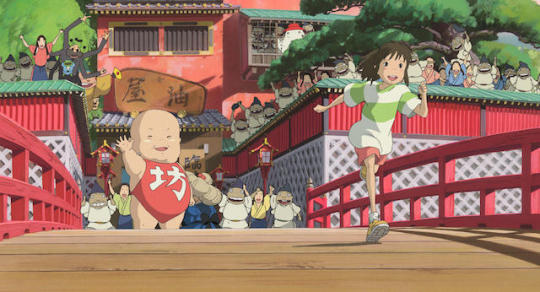
4 notes
·
View notes
Text
Spirited Away
I have watched Spirited Away a few times since I was small and love this movie. Honestly, one of the reasons for taking this course is this movie. In addition, I recognize that Gihbli works are really impressive both for small kids to adults. This time, I could find other good points of this movie that I did not find when I was a kid.
First, this movie tell us about environmental pollusion issue by human beings. For example, the scene where one of the big river gods visits the Yu-ya (bathhouse) is the most expressive in terms of pollution issues. At first sight, this god looks too dirty and stinky that Yubaba tried to deny entering the house, but because it is too late to do so, she have the guest and have Sen and Rin treat and clean the guest. However, Sen realises that the guest is polluted. In fact, from the guest, there are a lot of human waste out of the guest, and it turns out that the guest is actually a clean and famous river god. This scene effectively shows the social issues that human beings pollute the beautiful nature. In addition, the existence of Haku is also showing this social issue. Haku was initially the god of Kohaku River, but due to the construction, the river got reclaimed, which caused him to work at the bathhouse.
In addition, the process of Sen’s personal growth is also impressive. At first, she just follows her parents, and I got impression that she lives passively. However, since she starts to work for the bathhouse, she gradually live spontaneously. She decides her way of living by herself and persuades others. At last, she supports Bo and the creepy little creature and helps Haku live his own life. This process of her personal growth is really interesting. However, at the very last scene where Sen family walk through the tunnel is really similar with the beginning scene, which seemed as if Sen's self-development which was demonstrated throughout the film, was completely lost. Sen in the last has self-loathing look like her in the beginning scene, so I had a strange sensation.
Through this film, I was able to reaffirm the appeal of Ghibli films and I recognize that Ghibli is amazing.
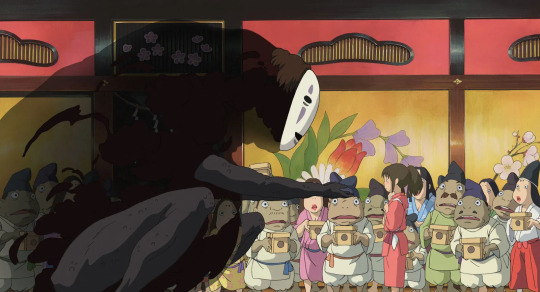
0 notes
Text
I agree that each characters except the gunman is so impressive that the gunman who might be the protagonist of this movie seems not important person. However, all actors seemed to be able to get the quirky roles down well and that's why the movie as a whole was interesting.
And as you mentioned, the contrast between Yoshitsune and Kiyomori's character is one of the biggest attraction of this movie, I guess. I got the impression that Yoshitsune has Japanese traditional mind. In constrast to that, Kiyomori is, I thought, was short-lived, and his way of acting is reminiscent of his famous tanka poem, "If you don't cry, let's kill you, Hototogisu.
Sukiyaki Western Django by Takashi Miike
In 2007, director Takashi Miike released the film Sukiyaki Western Django. This movie combined the essence of Japanese culture with the Western genre, following the trend of Spaghetti Westerns that became a global sensation after Akira Kurosawa's Yojimbo was adapted into a Western as A Fistful of Dollars. Despite most characters being Japanese, they all speak English, with Japanese dialogue appearing only twice. The film features a remarkably lavish cast, though some seemed to struggle with their acting, perhaps due to the challenge of performing in English. While the movie might aim for a Western atmosphere and international appeal by using English, I couldn't help but think that having the actors perform in Japanese with English or other language subtitles might have been a better choice. In short, it felt like an extravagant farce with a luxurious cast, complete with comedic moments and even a chabudai flipping scene. However, the top-notch cast performed the funny scenes with sincerity, and combined with the power of the action scenes and the elaborate costumes and sets, it was still enjoyable. But, I wonder if people unfamiliar with these actors would still find it entertaining.
One of the most memorable aspects was undoubtedly Minamoto no Yoshitsune, who, wielding a Japanese sword and handling guns stylishly, exuded charisma in every scene. As a fan of him as the actual historical figure, I was satisfied with Yoshitsune's portrayal, though the rape scene was not good though. In contrast, the leader of the Taira clan, Taira no Kiyomori, who adopts the name Henry, uses his subordinates as shields and behaves chaotically. Shigemori, who faithfully accompanies him and affectionately calls him Henry, is adorable. Also, Bloody Benten who is Akira's mother and Heihachi’s grandmother and has a large tattoo of Benten on her body is incredibly strong and beautiful. The scenes depicting the sorrow of Heihachi's mother, Shizuka, through dance and her enchanting performances were also excellent. All of the characters including the insane Yoichi and the sheriff, were very well-defined, and the actors truly embodied them, which was impressive. Perhaps because of this, the protagonist, the gunman, while cool, seemed slightly overshadowed. Quentin Tarantino's portrayal as the excessively meticulous uncle of seasoning and ingredients for sukiyaki was quite amusing. He came across as an anime enthusiast, hence the name Akira for his son, which was a nice touch. Akira seemed like a decent guy, and I wished we could've seen more of him. However, it was surprising to see someone like Shun Oguri used for such a fleeting role, and famous supporting actors appearing in minor roles like collapsing with bullet holes in his stomach. The use of the space created by the bullet hole was an amusing directorial choice. Nonetheless, it seemed like everyone had an extraordinary vitality; even when they suffered fatal injuries, they didn't immediately fall or die, which added a humorous element to several scenes.
The backgrounds that appear in the early and middle parts of the film give off a distinctively set-like vibe, over-the-top sound effects, anime-style inserts, and manga-like editing were also striking. While the storyline itself was somewhat typical, with no major twists, the outstanding performances and intense action made it immensely enjoyable. The juxtaposition of the red symbolizing the Taira clan, stained with blood, and the white snow symbolizing the Minamoto clan, along with the red and white flowers representing love blooming amidst it, was beautiful. The scene where a baby, Heihachi, emerges from these flowers is particularly memorable. Also, the confession scene where Toshio confesses his love for Ruriko, not as Bloody Benten but herself, and the scene where the sheriff falls with the crucifix were also impactful. If possible, I'd love to watch it again with Japanese subtitles.
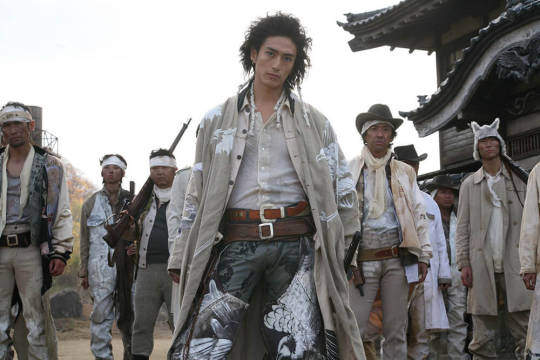
1 note
·
View note
Text
Sukiyaki Western Jango by Takeshi Miike
Overall, I felt this movie is made as a comic movie. In terms of Mise-en-scène in this film, almost everything is opposite from Japanese traditions, which makes the atmosphere of this film comical. For example, though the theme or the baseline of this fim is really Japanese history, like Genji and Heike, this movie is conveyed all in English. In addition, characters’ way of fighting is mainly guns . If the movie is authentically dipicting Japanese history, it should be Katana. Thier clothes as well are western style with hats, pants, not using Kimono. Cemetery style is Chrischan. Throughout the movie, I often see cross. Moreover, music used in this film are really like cowboy. Sometimes, even the mysterious and hilarious effective sound that is not suitable for Japanese traditional war movies is used, which makes me laugh.
In terms of edition, in some scenes, animation-like edition is used, so it made me confused like what kind of movie I am watching right now. I have two scenes that I remember the most. First one is the scene where the gunman (Hideaki Ito) jumped from the second floor and got ride on his horse. By editing the description of the jump to look like it's connected with a series of photoes, it seems to be like a hiro action movie for kids. The last edition is depicting Ruriko is really goot at shooting. In this scene, animation (the pictures that really tend to appear in cartoon) is used, which is so hilarious.
Although this movie is funny in almost every scene, what I got impressed is the last scene where Heihachi, who got traumatized by watching his father and mother’s death by his own eyes and could not talk at all, eventually spoke “love” as a proof of making a decision of his way of living from now by his own.
He even showed his smile to the gunman, which gave me the impression that the little boy is no longer dependent, but becomes an independent person.
Lastly, I will write what I could not get it about this movie. Although this movie title is named as Sukiyaki Western Jango, I could not find any reasons for the essence or the necessity of naming Sukiyaki as a title. It is true that Sukiyaki was depicted in the very beginning of the movie, but after that, it has no effect on this movie content. That makes me think why the title is Sukiyaki.
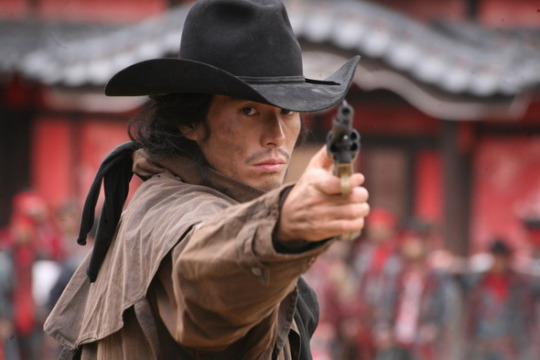
1 note
·
View note
Text
It is true that this movie failed to portray the fact of the discrimination against Hansen patients. The shot depicting their quarantine house was really short, and this movie just focused on what the freedom is in general by putting focus on Sentaro ((ex-convict)and also a little bit of Wakana (who has to give up with going to high shcool so that she can make money for her family).
Reading your comment, I recognize that in Japanese film industory or other media industory, they are really bad at portrating the fact or they often beautiflize social issues by making the film dramatic and they faild to dipic the nature of the issues. Of course it is really difficult to address the issues with the consideration of the victims. However, we as a audience of those films, we must not think what a movie is portrayting is all. Through the movie, we must try to know the truth.
Kawase - Sweet Bean
Pretty heartwarming story, I guess I'd say I like it but it is more like I don't dislike it. I think I now understand what Professor Smith meant by it being an award film, albeit in a different way. The specifics I'll get into in a bit but the film didn't really move me. I will say that the cinematography in this movie is beautiful, especially the color. The beautiful shades of green ang pink of the leaves of the trees shined against the blue clear skies.
The clear critique of this movie is Japan's treatment of disabled people, specifically those with Hansen's Disease. Right? I'd say not. Despite the fact that the film frames Tokue in a positive light. The film goes to great lengths to do so through the artisan's struggle. Such a large chunk of the movie is purely dedicated to just knowing how red bean paste is made and each shot is long and intimate with the process. Particularly the framing is great at depicting how lonesome these unconventional artisans are:
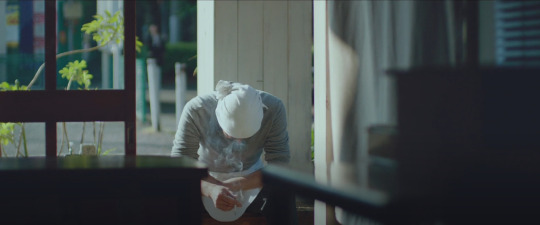
Sentaro is probably the one with the most shots like this, but we constantly see them alone, both finding a home in the other's company. However, when it comes to the critique of Japanese societal institutions, they are awfully light at that. We see the awful behavior of the gossiping landlord, but Sentaro is just forced to take it. We see Tokue's confined community, but not a single thing is said of it besides Tokue's wishes for freedom. It's almost like the film sidesteps actually addressing the elephant in the room.
On the other hand, I think a bigger focus on the film is instead purpose and freedom. Particularly, the three protagonists are all people who have failed to do their societal role. Tokue, an elderly diseased woman, wants to do strenuous work; Sentaro, an ex-convict, is working at a dorayaki shops despite not liking sweets; and Wakana, a child who has to provide for their parent and cannot go to school. These three are full of contradictions, and it is in to enjoy life despite their circumstances that they start finding meaning in their lives.
1 note
·
View note
Text
Ann
Through this movie, I learned the fact that there has been persistent discrimination against people with leprosy. In the movie, the owner’s wife told Sentaro that Tokue was a leprosy patient and she lived in a leprosy quarantine house. After knowing that fact, Sentaro and Wakana went there together. From the scene, first, I imagined that the house was like a hospital and located close to the hospital. However, it turned out that the house was located far from the society and hidden in the forest, so it is as if it were another country. This is where I learned about the reality of segregation.
In addition, what I was most impressed with in this film is the scene where Tokue told Sentaro that you were not wrong even though he could not protect her from the discrimination by society. Although Tokue has been isolated from the society, places with memories, and even her family since she was really small, she could say the message, which showed her strongness and well-established personality as a person. Moreover, for him, just one phrase of the message means a lot and I felt his guilt and unworthiness for not being able to protect Tokue and I was really moved by this scene. She was denied everything by society, including the possibility of having children, and just when she could finally experience the joy of being able to work, society turned its silent discriminatory eye on her again. However, when I imagined if I were an ordinary person in the film, I could not answer clearly yes to the question of whether I could continue to go to the store without feeling a sense of fear and danger, and a sense of disgust was born in me as well.
Lastly, I was impressed by her way of living. She said that if we try to listen to everything, including non living things, that is our meaning to live. I felt that her line reflected her humble and sincere way of life that never forgot her gratitude for everything, and that such a way of life was the reason why she did not lose hope in life even though society deprived her of her freedom. In the film, we can see her seeing and enjoying the scenery or nature many times. I found that these scenes showed her way of life.
Personally, this film is going to be the best movie. I learned a lot from this movie, and this movie made me feel like I try to listen to everythings.
0 notes
Text
I thought it interesting that this film addresses the fear come out of the nature, or the things we cannot know all about, and the fear from the internet as the same types of fear. It is true that this kind of horror or like traditional horror movie usually start or get inspiration from the darkness of the nature. Both fear come from unkown things. And I thought this movie criticizes our aspect where we feel fearness when we face a new thing (unknown things) and thus are eager to know everything and try to be omnipotent as much as possible.
In addition, our aspect nowadays gets stronger because of the internet. The Internet, which makes it easy to connect with someone or something anytime, anywhere, has diluted actual human relationships, and thus people are feeling lonely. In other words, this movie try to convey the message that the internet is the very root of the lonliness. That is why the internet are used in a negative sense in this film or these days horror movies.
Pulse (2001)
As a piece of horror I feel that Pulse was certainly effective in constantly maintaining a consistent sense of dread and unease throughout, even more so than the ring. Perhaps why it was far creepier to me than the Ring is that the particular technological anxiety that shaped Pulse was one that was common throughout my childhood. Pulse in many ways seems to play on traditional spaces of Japanese terror while giving voice to some rather severe anxieties surrounding the burgeoning internet.

The sea, mountains, lakes, and forests. These places are all home to Yokai, ghosts, and creatures of legend. Well, at least the stories of them. These spaces exist outside of the control of man. Their immensity gives way to anxiety. Pulse treats the internet in much the same way. The fear that is drawn within and out of the internet is not simply limited to ghosts and red rooms.
To say that there's dialogue in Pulse would be an overstatement. Characters previous to the climax of the film share more than a few lines of dialogue with one another. Conversation tends towards the aloof even among characters who are implied to be familiar with one another. Outside of highly simplistic question-answer exchanges no actual conversations take place throughout the majority of the film. It becomes evident as the film goes on and supernatural terror pushes the characters beyond rational limits that this was intentional. The internet and its vastness in the context of the film are horrifying but it is simply a space that gives way to and preys on loneliness in an impersonal and alienating society.
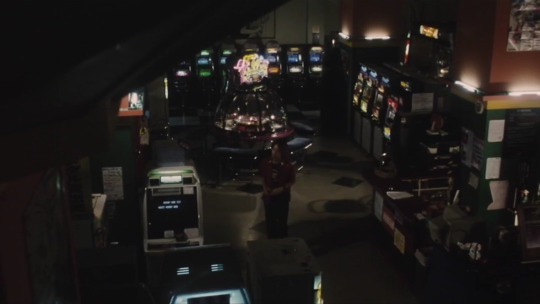
The sea, mountains, lakes, and forests in terms of folklore often function as spaces of transgression where offenses committed against nature or the divine are cast down with swift punishments. A man who defiles a mountain shrine might be cast down by a swift wind fanned out by a Tengu or fishermen casting their nets out at a place where a battle has taken place might have their ship suank by an Umibozu. Kurosawa employs the internet in a similar function, except the worst transgression is the one characters commit against themselves. Their seeming resignation to a lack of meaningful relationships or efforts towards creating genuine dialogue with one another are what leave characters most susceptible to being curse. The curse itself embodies all of these things, characters are reduced to the same noxious black stains left by corpses and for many of them as they plead for help or to be freed it is the first time they actually express their feelings in the film.
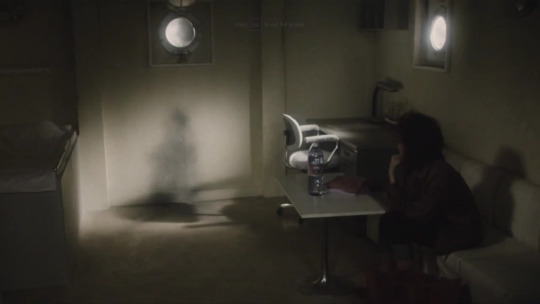
I just wasn't into it. Whenever I encounter this particular variety of media all I think to myself is "Jesus Christ, for the love of god, can't you fucking just have a conversation with one another. Would you rather become a dust stain?". Kurosawa's anxieties surround the internet as this incomprehensible space of danger and fear does remind me quite a bit of the discussions I myself often encountered surrounding the internet as a child.
1 note
·
View note
Text
Pulse By Kurosawa
My impression of the film was that the horror film element was lost from the latter part of the film. Especially, the scene where the airplane crashes into the building made me wonder if it had become a science fiction film.
Analysis
At first glance, the film dipicts Kawashima and Harue as contrasting characters. Kawashima is portrayed as an optimistic college student who does not face reality and dreams of living happily as a young man forever. Harue, on the other hand, is intelligent and has a tidy but inorganic room. She is so alone after the death of her family that she is convinced that she wants to die and be reunited with her family in the "other world". In addition, their way of seeing the reality is totally the opposite. Kawashima says that he never thinks about dying, or that someday he will be able to have a drug that will allow him to live forever, and Harue says that she will be able to join her family in death.
However, I think they are essentially the same. Their way of thinking about the reality is tend to escape reality regarding death and loneliness. In addition, they are both lonely in the movie. Kawashima does not have any scenes in the film where he contacts or works with his family or friends. It seemed to me that Kawashima was isolated at university without any specific friends and connected to the Internet to escape his loneliness. When we consider that Kawashima got a computer that he could not even use properly and connected it to the Internet because he had an image that "I can interact with someone using the Internet," it makes sense that there is no one around him. Although Harue has a few ostensible relationships with other students, whether they are taking the same lecture or are seminar students, who ask her for advice, her real life is solitary itself. Moreover, she has already been exposed to the Internet and knows that it is not a tool for solitude, although it can be a passageway between solitude and loneliness. In addition, she is becoming more and more interested in the afterlife every day.
In this way, while portraying these two seemingly contrasting characters, I think the film as a whole depicts the theme of human loneliness by making them share a common thread in their essential loneliness.

1 note
·
View note
Text
Hi Alex, I agree with your comment that camera work of this film was interesting. As you mentioned, the angle and viewpoint of the camera are depicting as the character's point of view, which effectively portrate the sense of fear felt by the characters. In addition, it is true that this movie is categorized as a horror becasue of or thank for its camerawork and its soundmusic. Storyline itself is not like horror.
But personally, I really hate this movie becasue it is scary and makes me feel uncomfortable.
Ring

Reviews of Ring tout it as horrifying, disturbing, and are generally very positive. However, I didn’t find this movie really all that scary at all. I judge whether a movie is scary based on if I get anxious thinking about it after viewing, and I just didn’t. During the movie, I only got startled by the sound design really, as the few jump scares were accompanied by loud sounds. I think I went into this film with inflated expectations from general opinion, so my enjoyment wasn’t that high.
One thing I did like about this film was the framing, specifically the use of narrow areas. In the opening scene, the girls hear the phone ring and go to check it out. A shot shows one of them walking down a hallway, and we, like the girl, are unable to see around the corner. Limiting us to the view of the characters did a great job of adding to the suspense that anything could be just out of view, ready to reveal itself. It also leads to a claustrophobic effect, most apparent in the well scene. That scene made me really uncomfortable, from the narrow space to the murky water, especially knowing that Sadako’s decomposing body was in there with them. I did also like the soundtrack. It did well subtly shifting the tone of scenes, and was only really apparent if you focused on it specifically.
As for the plot, there is a video tape with rumors that if you watch it, you will die in one week. Reiko investigates this and ends up watching the tape. Following some paranormal occurrences, she recruits the help of her ex-husband Ryuji, who she also shows the tape. I enjoyed the urgency that came from the one week deadline, with each delay or passing day adding significant worry to the characters, Reiko especially (Ryuji didn’t seem to have much concern for himself sometimes). The two eventually find out that Sadako, a girl born with paranormal abilities decades ago, and then killed by her own father, was behind this.
Thinking about it again, the lore, and the way it was introduced such as visions, were both interesting. Maybe because I just wasn’t in the right mood for the viewing, or maybe because I didn’t find it scary, did I think the movie was just alright. The ending explanation that you have to show the tape to another person to live created an interesting premise in that the story will continue cyclically, but it just wasn’t that impactful. Overall, I do see why this movie spawned a number of remakes and is enjoyed by a large fanbase, but it wasn’t for me in the end.
2 notes
·
View notes
Text
Ringu
Personally, I hate horror movies, so to be honest, I really did not want to watch this movie. Although my friends said that this movie was not scary and the storyline was really cheap, I felt it was really scary movie and I recognize I hate horror movies. In addition, I could realised that what aspects of horror movies I hate.
What I hate in horror movies is the mosic. It is true that the storyline and the content of this movie was not interesting and it is like mystery movie rather than horror. However, I see this movie as a horror because of the music used in the movie. All of the music incited anxiety and fear. Music made the atmosphere and made me feel scary. Especially, in the scene where dolly/pan shot was used to show staffs in Tomo’s room, the scary music was used, so though this scene only depicts the goods, it was really scary for me.
In addition, I was not satisfied with the part where the man who did his best to save the main character woman was cursed to death at the end of the movie. Furthermore, this man did help Sadako. Yet, he died. I can see the logic of his death, since he received the video from her, which has the meaning of transferring her curse to him. However, I wonder what it would be like to put a curse on someone who did everything in his power to save Sadako, and I was shocked that he could kill even one person who would put his heart into it that way .And, I felt that she was the one who was the cause of the curse, projecting the curse on her father in order to save her own son.
Other things I felt throughout this film were that it depicted people's desires, just like the last movie. The father who tried to use his own daughter, who has supernatural powers, as a tool to make money, is the cause of all bad things. The daughter was abused by the society because of her father, and because of that, she committed suicide, and because of that, Sadako lost her mother, who was the only one who cares and can protect Sadako. Thinking from Sadako's point of view, I could be resonated with her feeling that people should be resentful of her as a matter of course. Her mother was used as a tool for money and caused to death by people. The film conveys that taking advantage of people for one's own desires can lead to irreparable harm.
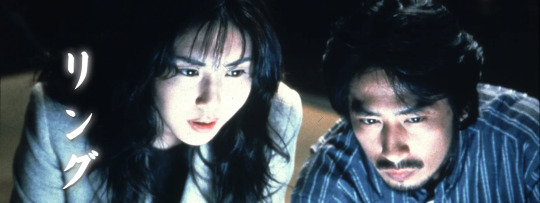
0 notes
Text
It was interesting point that noone in the movie tried to make an effort to make money by themselves. They try to find the easier way and by dicpcting those stories, this movie reminds us of the bad side of the ambitious.
In addition, from your comment, I felt I could get the title mean. It was intersting to read that their unlimited desire symblolized in the scene dipicting squashed butterfly Ageha saw in her childhood can be linked to the butterfly in Icarus of greek myth, tried to fly too high or sought an ambition to lofty, and forgot about the dangers it came with. I thought the interesting part was the fact that elements of stories from exotic countries were represented in japansese movie.
Iwai - Swallowtail Butterfly
This movie was a ride from beginning to end. I don't know if it was just my viewing experience, but I almost thought I was watching a series instead of a movie. This seemed to be another movie where vignettes or parts of a hole form to create an overall meaning to the film.
Figuring out an overall theme or message was a bit hard to figure out with the length and variety this film had to offer. But, if I had to say, I think Swallowtail Butterfly is a critique on ambitions power to corrupt people and tear communities apart. I think the obvious symbolism of this movie is not movie or yen itself, but how yen stands in for ambition. None of the characters truly seek to make the most yen they can, but to realize the wishes they so sought before but were not able to. The film then, presents us with an assemble cast of bizarre characters who seek to make yen, and in the process, forget about the community from which they came from. Once they realize that such a life is not truly worth it and that the yen has corrupted them, they return to the community. This can be likened to the squashed butterfly that Ageha saw in her childhood, a butterfly that, like Icarus of greek myth, tried to fly too high or sought an ambition to lofty, and forgot about the dangers it came with.
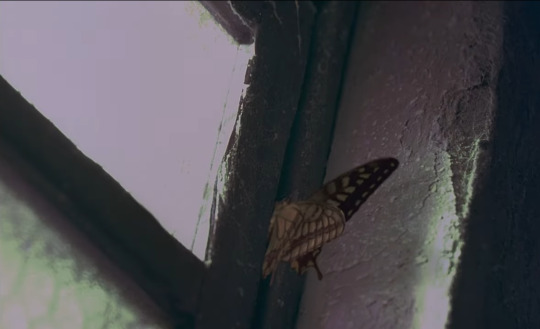
5 notes
·
View notes
Text
Swallowtail Butterfly
When I was watching the movie, I wondered why Fei Hong was bull-headed while being tortured by the police. If he would rather be violated, why not just make a statement as convenient and it would relieve him of the pain. I was sure that he had used counterfeit money, but I could not get why he was the only one being hurt in this way when he was not the only one involved. Even after watching the movie, the image of his tortured yet headstrong attitude remained in my mind. I have read a book called “The 7 Habits of highly effective people”, and I felt like I could understand how he felt at that moment. In the book, there was a section that said that people are free to receive stimuli (experiences) and how they react to them. The following examples were also given as evidence. A prisoner who was forced to live in a Nazi camp and was exposed to the situation next to torture and death was freer than any Nazi soldier. Because he had the freedom within him to choose his reactions to the stimili, and he was aware of and created them. He had gained the freedom within him to realize that no one could take away his own dignity and identity, even if they physically hurt him. The book helped me understand Hong’s reaction to the torture. Perhaps, I guessed, it was because he felt that no matter how much he was physically harmed, to react to it as the police wanted him to would be to pervert his beliefs. His beliefs are the way of life he has chosen for himself and the people he has decided to protect. He knew that if he chose not to be tortured any further, he would destroy his beliefs and self-esteem, which he had developed over the years, and he would be controlled by others, even his own dignity. I was able to understand this in my own way.
In addition, it was also interesting to see the process of Ageha's growth depicted in this film. It was exciting to see how Ageha, who had never spoken on her own, gradually grew up to become an independent adult, for example, by starting to make counterfeit money by herself or by making a decision to get a tattoo. Even in the final scene, Ageha throws a large sum of money made from counterfeit money into the fire. I felt that it showed Ageha's determination to break with her bad past and live on her own from now on.

0 notes
Text
Your analysis is so interesting that I could enjoy reading and also could understand this movie much more deeply. I learned from your comment that this movie makes us think how we live though we face with tragedies by comparing two characters' life. As you mentioned, I realised that Nishi chose to live by destroying everything. For example, he decided to live by acting agaist the law, though Hirobe decided to live creatively by reflecting his hope on drawing.
In addition, your analysis on the society where those who has obstacle are considered as not being able to contribute to the society and eventually got rejected by the society is interesting. In Hirobe's case, his injuries prevent him from being a cop or a father. I felt that a wife who abandons him as soon as he loses his role in the household of being unable to work as the family patriarch may be too much. Helping each one should make one family, but this movie tells us there are some people who cannot.
I was moved through your comment on Director Kitano's film with its message about life and the way we live.
Kitano - Hana-bi
Hana-bi is a really interesting film. At first I was pretty confused about the plot and themes, besides it being a proto-John Wick film. But then when I rewatched it, I actually really liked it. The cuts that used to feel sporadic felt like they were trying to instill certain feelings and imagery, and the characters were much more compelling. I think there's probably a couple of films like that in this class, where the viewing atmosphere or a rewatch changes your view on it.
I think that Hana-bi is a commentary on how people deal with tragedy and how material/social worth is the only indicator of success in society.
So obviously, the movie follows two main protagonist, Nishi and Hirobe, who are Japanese cops that throughout the movie face great tragedy. On one hand, you have Nishi, whose daughter dies before the events of the film and his wife is diagnosed with leukemia; on the other hand, you have Hirobe, who is shot by a gangster, leaving him permanently disabled from the waist down, and shortly after left by his wife and kid. Two horrible paths for these men to have gone down, but drastically different outcomes.
Nishi, in order to protect his dying wife and give her the best remaining life, choses to rob a bank to pay for his debts and kills any yakuza in his way. When faced with tragedy, Nishi chooses to take and destroy to deal with the pain. He's a man with almost nothing left to loose: his partner disabled, his daughter dead, and his wife on death's doorstep. Despite being a cop, he shows no hesitation to commit crime, even holding up innocent bank tellers to rob the bank. Similarly, he shows no remorse to the yakuza who not only permanently harmed his partner, but are constantly taking away time from being with his wife. In fact, it's not just the time on film, as a cop he was on the lookout for the yakuza on the regular, preventing him from visiting his wife at the hospital.
Hirobe is quite different from that. He was a man who had it all: an attractive wife, a child that loved him, a respectable job, and an able body. He loses all of that, yet instead of choosing to destroy, Hirobe creates. He takes up painting in his free time and creates beautiful pieces of art, some of which foreshadow later events in the movie. Admittedly, I understand Hirobe's arc less because of the large use of imagery, but to me it felt like Hirobe expressed what he wanted to do in his paintings.
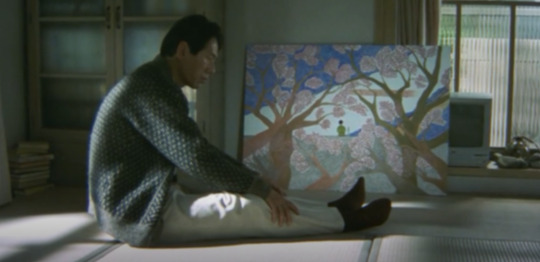
An alternate future is portrayed in his paintings, until the very end, where he throws paint over his suicide piece. Nishi and his wife both commit suicide, but Hirobe instead moves on from that feeling, finding a new purpose in life.
Through these men's tales, I think Kitano expresses how people deal with tragedy, some destroy and some create. The man who had nothing to lose, like a cornered animal struck back against the world trying to protect the only thing that still mattered. The man who had it all and lost it gained a newfound appreciation for life through his works of art that added meaning to the world.
Like I mentioned before, I also think that the film critiques the importance of material/social worth. Notably, this is still something I'm thinking over, but I couldn't quite put aside the connection in the depiction of Nishi's wife and Horibe. Nishi's wife, except by Nishi, is treated as some pitiful creature that is slowly awaiting her death. It's almost heartbreaking how in society's eyes, she almost doesn't exists, merely because she will soon die. Similarly, Hirobe is quickly discarded by society once he suffers that paralyzing injury. His beautiful wife and loving child abandon him once he can no longer work. In the film, society is quick to cast out these characters who suffer from a sort of disability that prevents them from performing their socially/monetarily important roles. In Hirobe's case, his injury prevents him from being a cop and a father, and Nishi's wife from being a wife, much less work.
1 note
·
View note
Text
HANA-BI By Takeshi Kitano
There were so many scenes that focused attention on the paintings. Personally, I felt the paintings were unique. For example, there was a scene that depicted a series of paintings in which the heads of animals were flowers. It was difficult to understand what these paintings symbolized. The fact that there were so many flower paintings may have been in line with the title of this film, Hana-Bi, but I thought that the superimposition of animals on the flowers was too unique for to understand. However, among such depictions of paintings, there was one scene related to the painting that I was able to consider: a scene in which a man killed someone with a blunt instrument. This is the part where the painting of the skeleton was used as a background showing the man after he had been beaten. This was reminiscent of death, and I thought this scene has the effect of the painting.
In the match cut that matched the gunshots, the transition was so smooth that I mistakenly thought that Nishi had killed the man, which is not true. Another scene that used the sound of fireworks to transition into a pyrotechnic painting was technical and interesting.
The couple's travel scene was very comical and interesting to watch. There were many amusing scenes, such as the wife not knowing that her husband, Nishi could see the cards through the mirror during the card guessing game, and he enjoying the game, and a car passing in front of the camera when they were about to take a commemorative photo. However, it was the contrasting last part of the movie that left a deep impression on me. I thought that the contrasting relationship between such an enjoyable trip and the last scene may be linked to the title of the film. When I saw the expression "Hana-Bi" in the title, I was curious as to why it was deliberately separated by Hana and Hi. However, after watching the movie, I guessed that the fun trip was exemplfied as flower which is Hana of Hana-Bi, and the two gunshots in the last scene were as fire which is Bi of Hana-Bi. I also thought that the gunshots, which appear frequently in the film, might also have been beautified as fireworks, finding similarities between fireworks and sound.
Throughout the entire film, I was surprised by the significant difference between the face Nishi shows in front of his wife and the face he shows in front of the men. The description of Nishi smiling happily was really short, and that was like the fleeting nature of fireworks.

1 note
·
View note
Text
I was impressed by your comment. Not only about North and South Koreans, and Chinese, but also people from oberseas are seen in a different and negative way in Japan, which is sad fact but still has been exist. And as you mentions, we judge and label people by their name. I think this is becasue name is playing a really important rople in discribing someone's identity. It is difficult to see people without one's social factors like nationality and race because of fearness of being unknown as you mention. Your comment makes me think what if people get to know each other without knowing any social factors. Will an image toward a person be less discriminative?
In addition, I am also a Japanese living in America, so I have felt some kind of judgement, so this movie becomes a really meaningful for me, too.
GO by Isao Yukisada
The movie "GO," directed by Isao Yukisada and released in 2001, depicts the protagonist Sugihara, who is of North Korean descent in Japan, and those around him. It is easy to imagine that Japan's impression of North Korea, South Korea, and China wasn't as favorable twenty years ago as it is now. While our generation and even younger ones may have a better understanding of each other, that bias has not entirely disappeared. Even today, there are still many people, particularly among the older generations like Sakurai's father in the film, who do not hold favorable impressions solely based on someone's nationality. This sentiment is not one-sided among just the Japanese; people from those countries may also feel similarly. Whether it's Sugihara's father changing his nationality to South Korean to make life easier for his son in Japan, his estranged brother as a result, or Sakurai's reaction upon learning about Sugihara's background, the film vividly portrays the impressions and realities between Japan/Japanese people and its neighboring countries and people at the time.
As Sugihara says, people tend to label others despite nationality, race or anything not being the sole defining factor of a person. This tendency stems from a fear of the unknown and is influenced by historical backgrounds, among other factors. It often happens, both consciously and unconsciously, for people to conflate the residents of a country with its government and history due to the influence of education and media. As a Japanese living in America, I often find myself judged, positively or negatively, solely based on being Japanese or Asian. I sometimes feel the innocuous biases, discrimination, and people's indifference which I did not notice when I was part of the majority. Hence, lines of Sugihara or other characters like eliminating the national borders or the relationship between Sugihara and Sakurai, who deliberately avoid mentioning names, and the quote about the unchanged beauty of a flower despite its name changing, all resonate deeply. It is a great film that inspires me to take pride in myself regardless of name or title and to want to become stronger to the point where I can think that and interact with others with that mindset.
Also, the camera work, music, pauses, and narration give an overall impression reminiscent of anime or manga, which was very cool. Particularly, the way the opening credits were displayed and the use of colors, along with Sugihara and his father's duel scene, were incredibly stylish and gave a nice adrenaline rush. The frequent cuts during running scenes or when Sugihara speaks at length emphasized both energy and the drag of the narrative, akin to anime, which was excellent. The sudden quietness highlighting his concentration during the study, followed by the return of ambient sounds with a ringing phone, was also impactful.
The saddest part was the death of Sugihara's friend from his Korean school days, Jeong-il. Despite expecting his death from his lines hinting at wanting to talk next time or having something to say, it was heartbreaking because he was a nice guy. However, his last scene when his steadfast sense of justice, kindness, and strength, are shown by protecting a female Korean student and the scene when Sugihara made a decision not to resort to violence to avenge, deeply touched my heart.
Moreover, I love that the film beautifully captures the atmosphere of Japan from the early to mid-Heisei era. Not only the landscapes, characters' clothing, hairstyles, and makeup, but also the way they exchange contact information with paper or converse using a landline, sneaking into school at night, or walking only on the white lines—all of these elements made me nostalgic for my childhood. Being born in the Heisei era, I have a deep affection for it, but seeing these films and those who spent their youth during that time made me even more envious. The atmosphere and stories of Heisei are truly the best. And above all, Yosuke Kubozuka, who plays Sugihara, is just too cool. Kingggggggg. Kou Shibasaki, who plays Sakurai, is adorable too, and there are many other talented actors still active today, making the film exciting. While there are many humorous elements, the film delivers a solid message, making it one of my favorite movies.
This movie hit me right in the feels, and I would watch it again and again because venturing out of my comfort zone to see the wider world and grasp what truly matters, friendship and love transcend nationality or titles, acknowledge and take pride in oneself as is, and love important people for who they are, these are the beliefs that I have held for the past few years and I just rethought and reaffirmed.
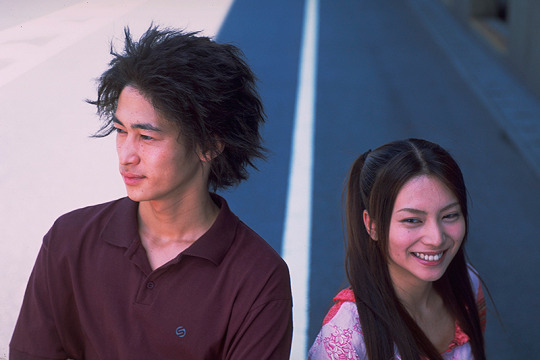
1 note
·
View note
Text
GO
Personally, I enjoyed this film the most so far. I enjoyed watching it because most of the actors were actors I knew. Also, I felt nostalgic because I could see a lot of Heisei culture in Japan, mainly from the maison seine. The clothes, hairstyles, atmosphere of the city, and even the love scenes had a Heisei atmosphere. I also enjoyed the scene where a parent beats his child and the police do not stop it, a totally different value ,system, and norm from today. I also felt the difference from Reiwa dramas. It is difficult to describe the atmosphere in words, but it was very good to realize that the atmosphere of dramas and movies differs depending on the era.
As for the camera work, the scene where the father says, "Look at the big world," was mostly shot on the ocean, which was effective in symbolizing the big world.
In terms of the storyline, the scene where he confides his nationality brings up the issue of discrimination. In Japan, there is an unfounded bad image of zainichi Koreans. This has been a social problem ever since the end of World War II. Especially with regard to second-generation and after-generation zainichi Koreans, issues related to nationality and identity are still an issue today. I think this film is very good in that it clarifies these issues. Perhaps because Japan is a conservative country, films that directly depict social issues tend to be avoided in Japan. However, this work is worthy of admiration because it directly addresses the issue of discrimination in the scene I just mentioned. Furthermore, the fact that it depicts this from the perspective of the Korean people is also admirable. Not only that, but Hirofumi Arai, who appears in this film, is a third-generation zainichi Korean. The fact that the actors are actually Korean residents of Japan gives the film a sense of reality.
The other memorable scene is the one in which the main character is talking with a policeman on a bridge. He attacks the cop when the cop asks him what his name is. Probably because his girlfriend was scared of him because he confided in her that he is a Korean national with his actual name. From this scene, I learn that there is an environment in which people have to hesitate to even say their own names. Also, in the scene in the schoolyard at the end of the film, the main character's words resonated with me, saying that human beings are insecure unless we give names to things. It is true that we feel uneasy when we encounter something we do not understand, and we are relieved when we find something with a name. However, I realized that these names are self-serving and self-serving.I had never really thought about zainichi, but through this film I learned what it means. I learned that zainichi can be taken to mean that one day they should leave Japan. In addition, I learned that a name that makes some people feel secure can make others feel uneasy or disgusted.
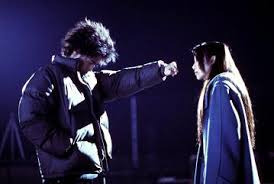
1 note
·
View note
Text
Hi!! I found your post is so interesting and many things to learn!! First, I found it interesting that the name of main character, Tampopo has the means of the symbol of courage, strength, and perseverance. It is true that throughout this film, she rebels against the normal thing considered in the society. This reflects the story that one woman will succeed in the ramen shop owner. In addition, I realize that some random scenes have meanings.This is what I could not understand when I watched this movie. As you mention, there is a common characteristic in those random scenes, which is that they are all scenes related food and damage it. I felt your point where this damage of food implies Tampopo’s attitude toward the ramen shop and the society!
3/18/24 "Tanpopo" JPT 3391

I watched "Tanpopo" two and a half times because of how initially absurd it appeared to me. I was hellbent on figuring out what it was trying to say, because I saw a connection but I didn't know what it was.
Tanpopo on Ego and Defiance:
I left this movie with the impression of a commentary on hard work, ego, and a discourse on professionalism. Tanpopo really screams at the watcher that anybody can be a 'professional' at something, while simultaneously begging the question of what a 'professional' even is. "Tanpopo" pokes fun at those who think they know how to make/eat the perfect ramen, while simultaneously praising and building up the main character, who initially didn't even know how to cook well, into a ramen connoisseur! Our main character is called Tanpopo, meaning dandelion (perhaps related to her being a symbol of courage, strength, and perseverance, as it's a weed). She starts as an ambitious but inexperienced cook, who instead of becoming upset or discouraged by critique, runs with it, ending the movie with a transformed look, a transformed shop, and a new ramen recipe ("Tanpopo ramen"), signifying her transition into a professional. The film critiques the ego of the professional ramen cooks who don't accept criticism and refuse to share knowledge, showing that there is not necessarily a 'proper' way to do things (such as eat ramen or slurp), but instead several good options that one needs to explore themselves. So then, what is a professional? What I took from this movie is that it is somebody who is skilled at their craft, willing to take critique, and willing to share their knowledge with others.
But if that's it, then what were all those strange cutaway scenes about? I initially evaluated Tanpopo as an absurdist comedy- and in a sense, I still feel like it's absurdist! But, to me, the nuance comes from the way in how it conveys it's themes- using several unrelated and comical scenes that share one unified message of defiance! The old woman poking holes in produce, the homeless man who broke into a kitchen just to cook a tasty omurice, the group of girls slurping noodles WAYY too loudly, the employee that stuns his superiors by ordering a high quality dish, and the couple that... has sex using a shrimp? (gross). All of these scenes involve breaking a mold some way or another, with food as their medium. Rebellion, whether ethical or not, revealed itself as a reflection of Goro's character, who watches Tanpopo defy social norms as a solo female ramen chef and was passionate to help her surpass her 'professional' rival cooks.
Unfortunately, I wasn't able to loop all of these scenes together as one. The man who ate the oyster sexually from the girl's hand, the man that forced his wife to cook dinner until she died, and the man who died from a gunshot wound speaking of roast pig (ironically, while leaning on a pig), were all unknowns to me.
Food used as a storytelling device:
This movie took something as "simple" as ramen (and other foods) and turned them into an art form, a story, and thus a movie. While it may have not been the director's intention, I left Tanpopo with an appreciation for the mundane, whether it be ramen, cereal, or a walk in the park, and I appreciated what I felt was people using one small object in order to tell a complicated story about growth and change.
Character Shenanigans:
I was a fan of Goro, the most prominent side character of the film. There was a very obvious cowboyish western feel to his character, including the cow horns on his truck (steed?), him almost always keeping that damn cowboy hat on, his penchant for a tussle, and him disappearing without a word at the end, despite saving the town from peril.
Did anybody else get a Seven Samurai feel? I know there were only 5 'helpers', but if you could Tanpopo and her son, then that makes seven! Anyways, not sure if that was just me or done on purpose, but each man helped Tanpopo in her own way.
5 notes
·
View notes